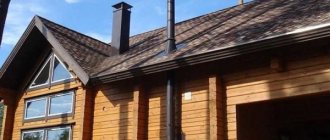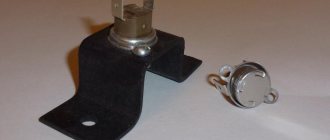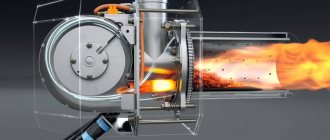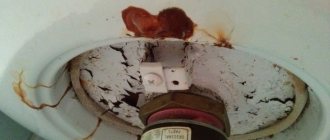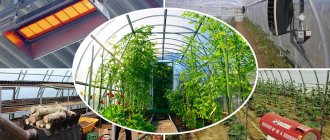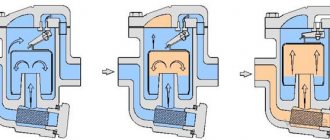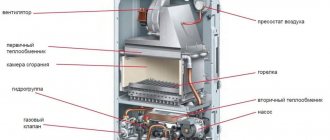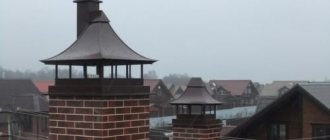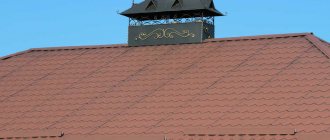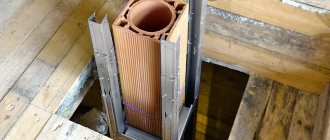The principle of operation of the stabilizer
If the thrust force in the system begins to exceed its optimal values, then a valve opens in the regulator, which reduces the pressure and thermal lifting force due to the air coming from the room and mixing with the flue gases. The valve will remain open until the temperature drops and reaches the optimal level. Further, the valve will automatically close, the chimney system will continue to function properly.
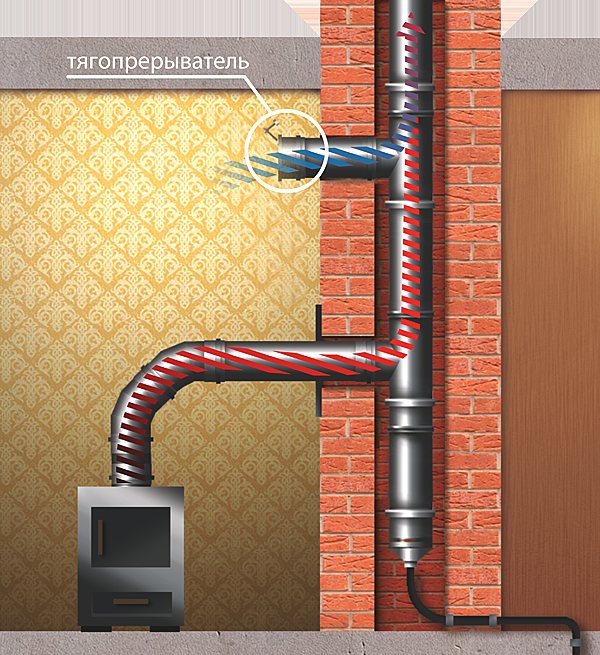
This method of maintaining good traction is simple and effective. Fuel in a furnace or boiler will be burned evenly and consumed economically.
The installation of a chimney draft stabilizer provides the following advantages:
- improving the safety of the chimney system;
- reducing the amount of harmful substances emitted into the atmosphere;
- better circulation of air flows when the valve is kept ajar;
- the possibility of functioning both on forced and natural draft;
- uniform combustion of fuel in the boiler, which makes it impossible to overheat the chimney;
- protection from strong gusts of wind;
- no burning smell in the room;
- increased service life of the smoke exhaust duct;
- preventing heat loss;
- possibility of installation in modern low-temperature boilers;
- ensuring fuel economy by 15-20%.
What is a chimney draft stabilizer and how it works
The device is a mechanism that provides a metered air supply for optimal traction in automatic mode. The breaker - chimney stabilizer - is equipped with a safety flap, by means of which the risk of overpressure is eliminated. The principle of operation of the regulatory mechanism is as follows:
- in case of an excessive gas flow rate, a damper in the thrust compensator is triggered, which causes a partial cut-off of the jet;
- the valve position is maintained until the temperature in the furnace drops to optimal values;
- after the temperature regime is adjusted, the damper returns to its original position.
The formation of high draft in the chimney is caused by climatic and daily changes, atmospheric pressure, significant temperature changes and other factors. The increased intensity of flows in the smoke channel negatively affects the operation of the system - the efficiency of the heat generator decreases, and fuel costs increase. To eliminate problems with pressure in the chimney pipe, a draft stabilizer is needed.
Automatic pressure compensators in the smoke exhaust duct are a universal device for all categories of heat generators. The construction is made of stainless steel and provides compact dimensions. The device stands out for its relatively simple mechanism, ease of installation and maintenance. Often, for the arrangement of autonomous heating systems, a traction stabilizer is made by hand.
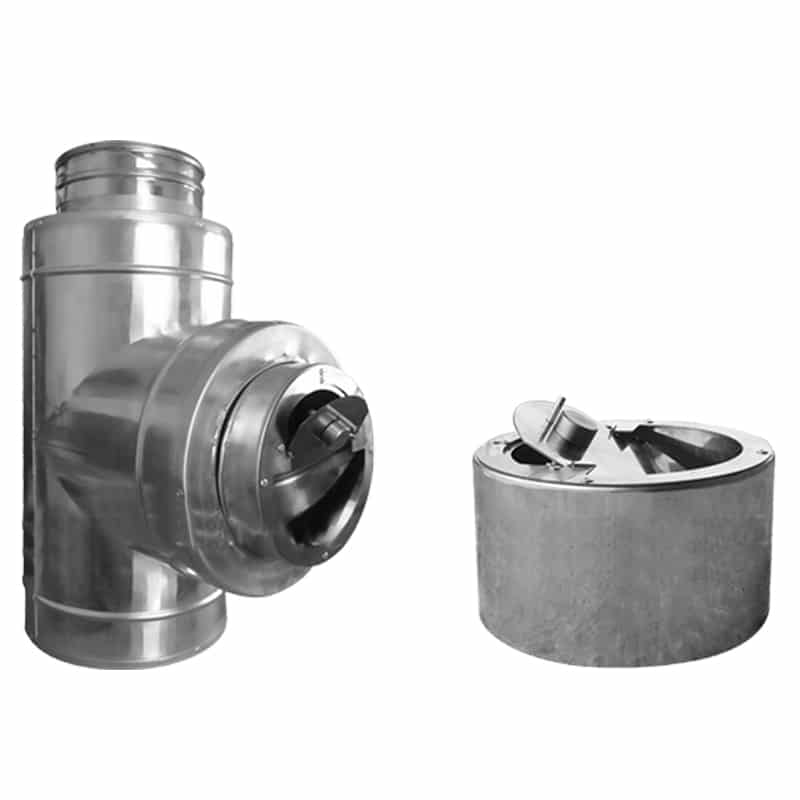

Chimney draft stabilizers
Advantages and disadvantages
Equipping a heat generating unit with a draft regulator is considered the most effective way to ensure uniform fuel combustion. This is the key to energy conservation and significant savings in combustible resources. Also, among the advantages of installing a pressure stabilizer in the chimney, the following points are noted:
- the efficiency and safety of the system as a whole is ensured, since uniform combustion of the fuel occurs and overheating of the chimney is excluded, which leads to an increase in its service life;
- the efficiency of heating equipment increases, the level of heat loss is leveled, energy savings are up to 15%;
- the possibility of smoke and burning into the room is excluded;
- the level of emission of harmful compounds into the atmosphere is qualitatively reduced.
The equally impressive capabilities of the chimney stabilizer are also impressed with both natural and forced draft.
It is noteworthy that the automatic traction force regulator makes it possible to connect new models of boilers of low-temperature categories to the old chimney system.
This is interesting: Butterflies on the wall in the interior of the apartment - we explain in detail
Chimney construction
When building a chimney with your own hands, without special skills and consultations with specialists in its operation, such negative phenomena as a rupture of draft, excessive draft, and a number of other problems can accompany. That is why, when wondering how to make a chimney for a gas boiler correctly, or make a chimney for a gas boiler in a private house with your own hands, you must first contact the appropriate services, where a diagram or project will be made. It will indicate the place where the gas column can be located, what the outlet pipe should be, whether deflectors should be installed, and what requirements the ventilation duct should meet.
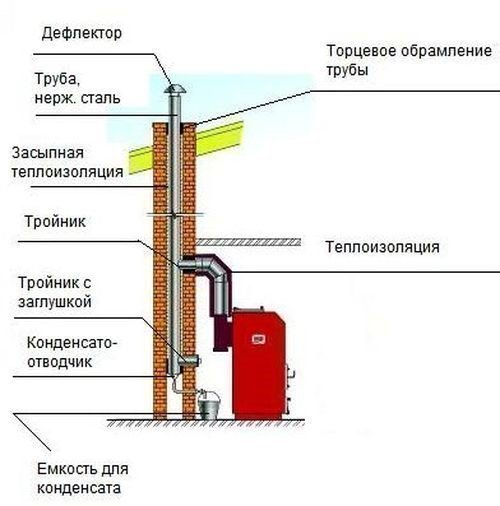

Chimney device
When wondering how to make a chimney for a gas boiler, do not forget that there must be a draft in the chimney of the gas column that supports the normal process of constant combustion. Otherwise, if the draft is insufficient, this can lead to the damping of the flame and the subsequent explosion of the domestic gas. Therefore, during construction, you need to pay attention to the chimney pipe, which must have dimensions that meet the requirements of specialists.
The device and purpose of the stabilizer
The draft stabilizer is an additional insert on the chimney with a damper, with which it is possible to regulate the intensity of fuel combustion and the force of draft in the pipe. The draft stabilizer is installed only on low-temperature heating equipment, where the maximum heating of the exhaust gases does not exceed 500 degrees.
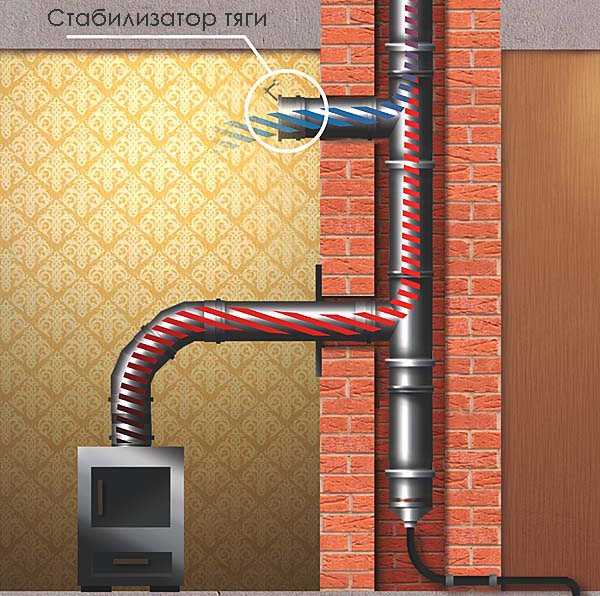

Purpose of the traction stabilizer:
- reduce the rate of removal of combustion products from the furnace;
- prevent the formation of back draft in the pipe and the throwing of smoke into the room;
- extend the life of the chimney by lowering the emission temperature;
- to increase the fire safety of heating equipment by preventing the emission of sparks and flames from the pipe;
- reduce fuel consumption;
- increase the efficiency of the furnace.
The draft stabilizer is installed in three locations and only in the boiler room:
- The first option is above the furnace outlet on the first vertical pipe segment. The distance from the stabilizer to the horizontal section is 40-60 cm.
- The second option is at the level of the chimney outlet from the stove, but not lower than 40 cm from the floor level.
- The third option is shown in the diagram.
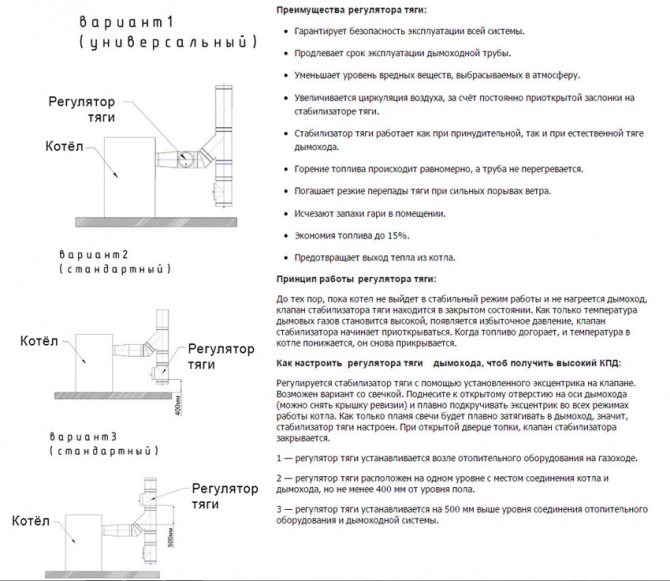

The smoke regulator is an additional entrance to the chimney for air intake. The device is a horizontally oriented branch pipe, one end of which is closed by a vertical movable flap, and the other is built into the chimney. The damper must exactly match the inner diameter of the nozzle so that air does not leak in the closed position.
The damper is the main working part of the draft stabilizer. It can be attached to the case on a movable axis in the upper part, which is typical for factory devices. Homemade dampers are usually attached to the axle through the diameter.To prevent it from tipping inward, clamps are placed at the bottom. The device is mounted on a vertical pipe, without inclination. On a finished sandwich pipe, it is convenient to do this through a conventional tee.
Principle of operation
There are two types of draft regulators - automatic and mechanical, manually controlled.
Reducing the draft in the pipe
The automatic draft stabilizer is a kind of membrane that reacts to changes in the density of smoke in the chimney. When the draft increases, the damper opens and admits an additional flow of cold air into the pipe. This helps to cool the combustion products, the gases become heavier and rise more slowly, the thrust decreases.
It is interesting! The smoke pressure is adjusted very quickly and the damper on the smoke regulator moves back and forth continuously. Since the part is metal, it emits a characteristic knock during operation. In the common people, the traction stabilizer was nicknamed the cracker.
The mechanical smoke regulator is manually adjusted. To do this, there is a weight on the lower part of the regulator flap. When making a device with your own hands, it is convenient to use an ordinary bolt as a weight. The stabilizer is adjusted during the period of maximum fuel combustion. By tightening the bolt, the center of gravity of the damper is shifted in the desired direction so that it is kept closed at the required gas pressure in the chimney, and when it rises, it opens.
We recommend that you familiarize yourself with: How to independently weld a gate from a profile pipe
Backdraft prevention
The throw of smoke into the room (back draft) occurs when the pressure of the smoke in the chimney drops sharply and significantly. This happens when the weather is windy, when the furnace is opened, when the outside temperature changes. The traction stabilizer is sensitive to these changes and shuts off the cold air flow (the damper closes completely) as soon as this occurs. When the pressure rises above the desired value, the damper opens again.
When traction isn't enough
Methods for determining thrust
If you do not have an anemometer, use one of the popular methods for determining chimney draft:
- Smoke. The most obvious sign of a lack of draft is the presence of a small amount of smoke indoors, a large amount of smoke indicates a high risk of ignition and the risk of food poisoning.
- Flame color. By the color of the flame, you can understand the level of thrust. If the flame inside the stove is white and cracks when burning, then the thrust is very powerful. An orange-red color indicates a lack of traction. If the chimney is made correctly, the flame should have an even golden color that goes into yellow.
- With a match. It is necessary to bring a lighted match to the heater. If the flame deviates to the stove, then there is a draft. If it remains level, then you can be sure that there is a thrust, but of average magnitude. When the flame deviates in the opposite direction from the stove, back draft occurs in the chimney.
- With a mirror. Another way to check chimney draft is to attach a small mirror to the stove. Condensation on the surface of the mirror indicates that it is difficult to remove the smoke.
Attention!
The difference in pressure outside and indoors is the basis for creating a draft inside the chimney. The temperature in a heated room is higher than outside, and, therefore, the pressure it creates inside the room is higher. Hot air, supported from below by colder air, is squeezed out into a zone with a lower pressure, that is, into the atmosphere. When measured in summer, the temperature difference is the least striking, so the thrust will be worse and the measurement results may be low relative to the winter period.
Causes of malfunctions
After making sure that there is not enough draft inside the chimney, it is necessary to identify and correct the possible cause. Professionals say that the most common causes of chimney failure are.
Design error
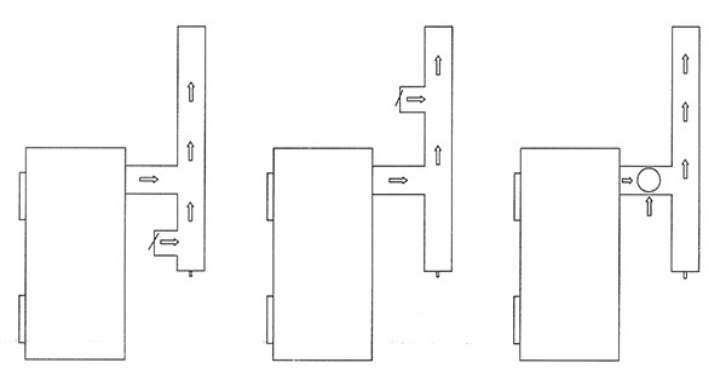

To make the choice of a chimney pipe, it is necessary to focus on the volume of the firebox. If the size is less than the calculated parameter, then a weak chimney will not allow smoke to leave the room.
Short pipe length
Pipe lengths less than 5 m do not have a significant difference between indoor and outdoor pressure, which creates a weak draft.
Incorrect position of the chimney pipe
The master stove-maker advises to lay the chimney vertically, as tight corners keep the smoke inside the chimney, reducing draft.
Long horizontal sections
If horizontal sections cannot be avoided when laying the chimney, make sure that their length does not exceed 100 cm, otherwise, an amplifier will be needed for this.
Getting into the wind support zone
If there is a tall building next to the house, it blocks the chimney from the wind, interfering with the normal functioning of the chimney system.
Weather conditions
Often, a decrease in draft occurs due to a decrease in atmospheric pressure, moisture ingress into the chimney due to rain, fog or snow. But this is not critical, because all these are temporary phenomena.
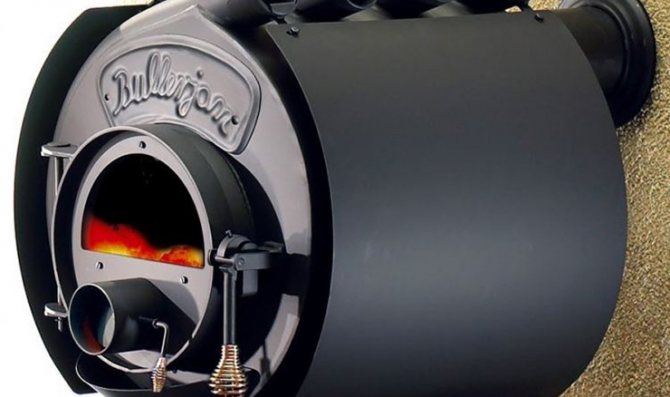

What is the stabilizer for?
The full operation of the chimney and high-quality draft directly depend on the weather conditions and the time of the year. For example, in case of sudden temperature changes in winter and in windy weather, the air draft in the chimney increases significantly. At the same time, to maintain a normal temperature in the room, more fuel is required, which leads to a decrease in the efficiency of the entire chimney system. In this case, a stabilizer will become an excellent assistant - a draft regulator in the chimney, capable of maintaining optimal values without allowing them to increase. Accordingly, the heating device will function more efficiently and harmoniously.
In addition to weather conditions, the quality of traction is greatly influenced by atmospheric pressure, which in turn can change dramatically depending on weather conditions, time of day, year, location of the house. The pressure decreases significantly in wet, cloudy weather, which often occurs in March-April, stabilizes closer to autumn, and remains within the normal range on clear cool days. Nevertheless, the difference in atmospheric pressure drops can reach 90 Pa, which affects the serviceability of the chimney. Therefore, in this case, one cannot do without a quality regulator.
How to make a traction stabilizer with your own hands
To make a traction stabilizer with your own hands, you will need to prepare tools for working with stainless metal and material for making the regulator itself.
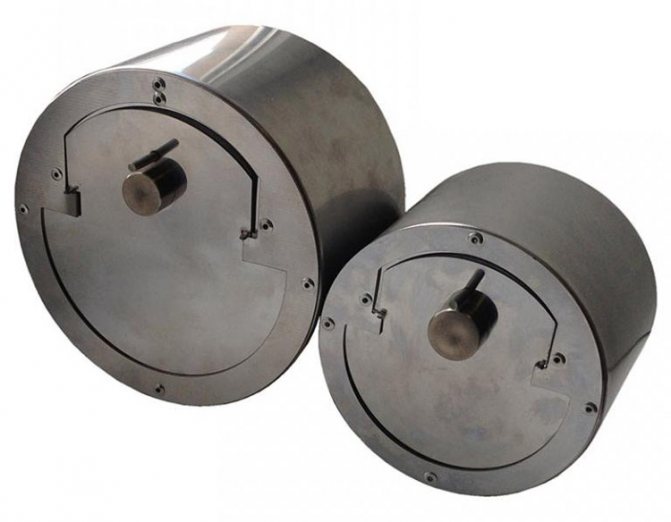

To work you will need:
- Welding machine for working with stainless steel. It can be a gas welding or a DC inverter.
- Stainless steel electrodes diameter 4 or argon for gas welding.
- Grinder, cutting and grinding wheel.
Materials for the manufacture of the traction stabilizer:
- Metal sheet made of steel grade AISI 304 (analogue 08X18H10) or AISI 321 (analogue 08X18H10T). Metal thickness 10 mm.
- Bolts, nuts, metal rod with a diameter of 10 mm - all made of stainless, heat-resistant steel.
The installation diagram is as follows:
- It is required to weld a branch pipe from a sheet of metal - the body of the regulator. Calculate the diameter based on the diameter of your chimney. You will need to put the stabilizer on a tee or branch pipe extending from the main pipe. Therefore, the inside diameter of the stabilizer must match the outside diameter of the tee. Usually it is 115 mm, but it can be more.
- The metal for the body should be cut with the calculation of an overlap welding with a seam width of 1 cm.
- The cut sheet is rolled and welded. The seam is smoothed to smoothness on the outside and inside.
- Roll the boundary barrier at a distance of 40 mm from the edge at the end of the body.It will serve as a stopper when mounting the device on a pipe.
- On the other end of the body, in the lower part, weld stoppers to prevent the damper from overturning inward. In the upper part or in the middle (depending on the shape of the damper), fasteners for the pivot axis are welded.
- A shutter is cut out of metal. Its size is equal to the inside diameter of the outlet of your enclosure, or matches the contours of the outlet if you decide to reduce it.
- A hole is drilled in the lower part of the damper for the adjusting bolt.
- In the middle (for a symmetrical damper) or in the upper part (for an expanding form), a pivot shaft is welded.
- Install the flap on the body.
- Install a draft stabilizer on the pipe.
When installing the stabilizer on the pipe, coat the points of contact of the pipes with a heat-resistant sealant. This will make the connection more durable and tight.
Regulator location
The stabilizer is installed in the same room where the boiler is located. The interrupter is mounted on a vertical pipe in two ways:
Installation is carried out at a distance of 400–600 mm from the junction of the exhaust pipe from the furnace and the main chimney.
The chimney draft regulator is mounted at the level of the stove, at a distance of at least 400 mm from the base. In other words, they are attached at the beginning of the main part of the chimney.
Possible gaps are filled with high temperature sealant. Sealing with asbestos, previously soaked in water, is allowed.
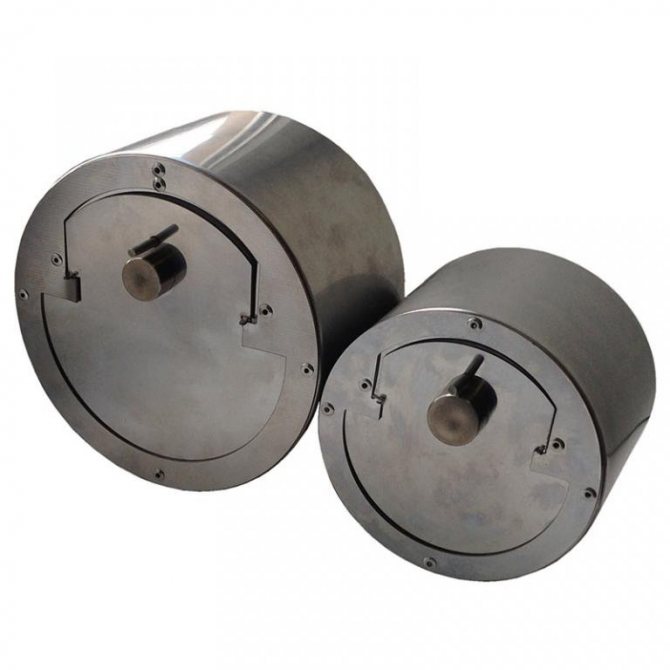

Regulators of different sizes.
Draft regulator models
There is a wide variety of models of chimney draft regulators produced by various manufacturers on the market today.
Let's consider the most popular and demanded ones:
- RCO. Models in this series are fixed with clamping clamps and only to a round pipe. They have found their application for chimneys with a circular cross-section along the pipe axis. The chimney draft stabilizer is installed at the very end of the pipe. Given the fact that modern chimneys usually have a rounded shape of pipes, such regulators have gained wide popularity. Such devices are the easiest to install.
- RCR. This stabilizer is installed directly on the chimney and is fixed by means of special clamps with the possibility of regulation in the range of 120-200 mm and is installed at the boiler outlet. The harsh domestic climate presupposes the use of similar regulators for chimneys made of ceramics, steel and asbestos. Chimneys with a draft regulator in the range of 10-35 Pa cannot boast of high quality, however, if necessary, they can be installed.
Chimney draft regulator RCR series with adjustable clamp
RCP. With a draft regulator in the range of 10-35 Pa. Installation of such a device is carried out by overlaying and fixing the regulator to a flat surface. The chimney draft regulator for fastening is provided with hidden holes in each corner.
Chimney draft regulator RCP series for surface mounting
RCW. This regulator with a draft regulation range of 10-32 Pa, has established itself as a good draft regulator in ovens, boilers, fireplaces. For the manufacture of the case, stainless steel is used, thanks to this you can fix the device with glue, a special solution. You can also use the release springs and fix it to the ventilation grill.
Chimney draft regulator RCW series for brick chimneys
Summing up all of the above, it is worth noting once again that the chimney draft regulator is a very important element of the heating unit, which directly affects the functioning of the entire heating system.
Traction stabilizer placement options
The chimney draft stabilizer can be installed in the same place where the heat-generating device is mounted, or in the adjacent room, in which the outlet from the boiler or stove to the flue system is arranged. The pressure can range from 10 to 35 Pa.
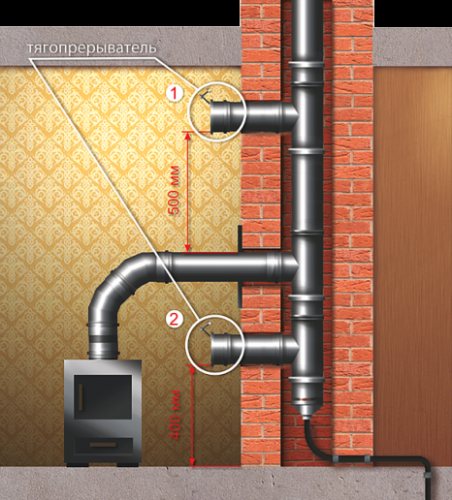

There are two main ways to install a traction stabilizer:
- the device is placed 500 mm above the level of the junction of the heat-generating device with the smoke exhaust system;
- the draft stabilizer is installed at the same level as the connection of the heat-generating device with the chimney, but this distance should be at least 400 mm from the floor surface.
Also, most manufacturers of heat-generating equipment recommend using special stabilizers, popularly called "fungi". Such a draft regulator is a small section of a chimney with a mushroom-shaped expansion and an open area under it for the flow of outside air. Such a constructive solution has the following advantages in comparison with the traditional chimney outlet:
- stabilization of pressure in the furnace of the heater;
- elimination of excessive draft in the chimney, and, accordingly, normalization of the efficiency of the heat-generating device;
- protection of the heat-generating device in the event of reverse draft in the chimney system;
- traction control.
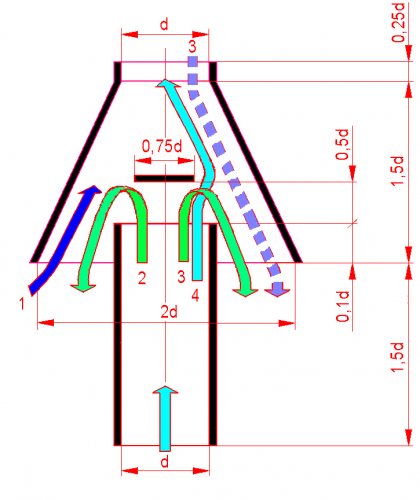

1-air flow from the room where the heater is installed;
2-short-term, no more than 60 seconds, discharge of exhaust gases into the boiler room;
3-direction of exhaust gases in case of traction overturning;
4-direction of the exhaust gases of the heating heat generating device.
A special stabilizer sensor is mounted under the cap in the form of a fungus and is triggered when the temperature of the combustion gases changes. In the event that there is a deterioration in traction or the occurrence of the opposite effect, the exhaust gases released during the combustion process will collect under the fungus and lead to the heating of the sensor, and this, in turn, will cause the gas supply to the burner to be cut off and the heating device will automatically turn off.
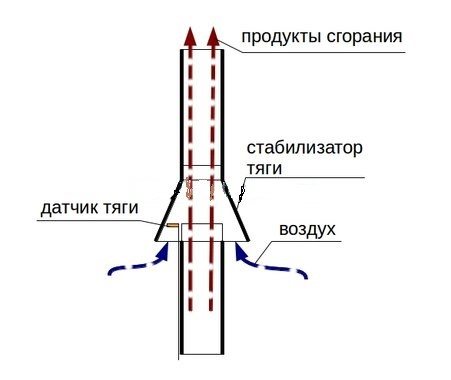

The direction of combustion products and air flow through the sensor with normal draft in the chimney
In the chimney, the effect of reverse draft is observed - the combustion products are forced to go under the umbrella to the sensor
Some owners of private houses or cottages build all kinds of heat exchangers into chimneys to collect residual heat from combustion products and reduce fuel consumption. However, it is strictly forbidden to do this, since in this case the flue gas discharge worsens due to the narrowing of the chimney and the sensor will certainly be triggered.
Structurally, the chimney draft stabilizer sensors are divided into:
- thermocouples;
- liquid;
- thermistor.
As a rule, their installation does not present any problems. Stabilizers are traditionally installed using self-tapping screws and nuts on mounting pads in specially prepared holes.
Ways to increase chimney draft
The purpose of the draft regulator is to extinguish excessive vacuum in the chimney. The stabilizer cannot increase traction. What to do when the thrust is clearly insufficient?
To increase traction, do the following:
- They check if the chimney channel is clogged with soot, clean it.
- Check if there is air access to the room or air supply from the street to the heating unit firebox. If necessary, open a window or conduct a pipe to take in clean air from the street.
- Analyze whether the pipe is sufficiently insulated, whether the insulation is wet. In the case of modern ceramic or sandwich pipes, insulation can be considered sufficient; when insulating steel pipes with your own hands, unpleasant surprises are possible. It is also desirable to insulate traditional brick pipes.
- Find out if there is a baffle on the top of the pipe. Often, installing a deflector will solve the problem.
If all searches did not lead to a solution to the problem, it is worth inviting an experienced heating engineer - the safety of the family is above all.
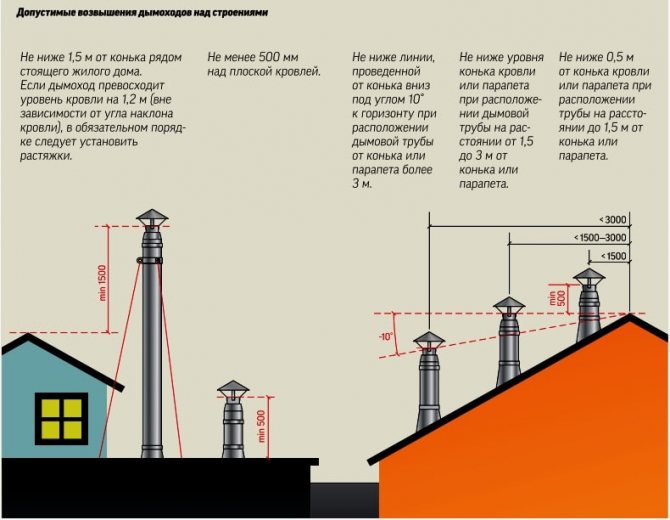

If you have changed the heating unit to a more modern one (or moved the stove or fireplace), then you must:
- Calculate the minimum length and cross-sectional area of the hog depending on the power of the heater (see my article on calculating the chimney).
- Consider the required pipe height depending on the location relative to the ridge and the wind support zone of tall buildings and large trees.
- If the chimney is of insufficient height and cross-sectional area, then either build it up or mount a smoke exhauster - a special fan. It is installed on the pipe head.
- If the old pipe has a cross section that is much larger than the calculated one, this problem is eliminated by using a gate or installing an insert. If the pipe is too long, a gate can also be used.
When replacing an old stove or fireplace with a modern boiler, the pipe will probably have to be modernized, since modern boilers have high efficiency, aggressive condensate and a low temperature of exhaust gases. Even modern solid fuel units have a lower smoke temperature than old wood-burning stoves.
Methods and devices
During normal operation of the chimney, the pressure of the upward flow should be in the range of 10-20 Pa, which corresponds to the optimal flow of exhaust gases from the combustion chamber. To find out the real state of affairs, anemometers are used that can show the level of thrust. Based on the readings of the device and the result of burning fuel, you can say for sure whether you need to increase or decrease the thrust, use stabilizers that will automatically maintain the ideal air flow rate in the channel.
There are many ways to increase traction or bring it in line with the standards and requirements of the boiler manufacturer:
- Increasing the chimney height;
- Use of deflectors, weather vane, rotary turbines as a chimney head;
- Using smoke exhausters powered by electricity;
- Traction stabilizers.

